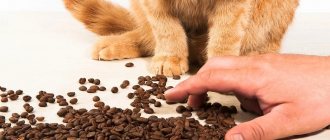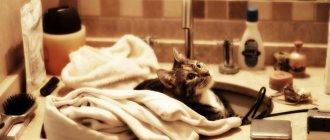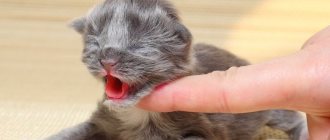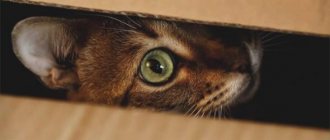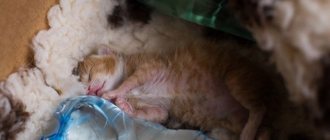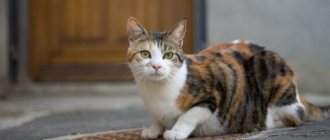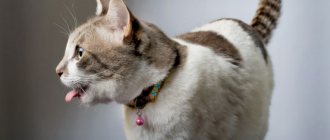Often cats suddenly develop health problems, and the owner does not know what to do or how to help the pet. If the cat cannot go to the toilet in a small way, then, of course, you need to quickly contact a veterinarian. In our article we will try to explain in more detail the problems of this disease, what the causes of this condition may be, and how to provide all possible help to your pet.
How much should a cat urinate normally?
Before moving on to the description of deviations, it is important to mention the recommended standards. Changes in the usual volume of urine and the frequency of trips to the toilet will tell you about the pathology.
Volumes
The exact indicator is determined individually based on the following factors:
- Type of food.
When feeding “natural” food, the body receives not only clean water, but also liquids from foods. This is reflected in the volume of allocations.
- Weight.
Obese animals have less bladder control, so their litter box needs to be changed frequently.
- Age.
Unlike an adult, a kitten is simply not able to make a puddle that is too large due to its size.
- Floor.
During pregnancy, a cat pees more than a cat due to constant pressure on the uterus.
On average, the volume of liquid coming out is 50-200 ml. It can be measured with a measuring cup, after removing all the filler from the tray in advance.
Frequency
Before puberty, kittens pee up to 5 times a day. With age, the frequency of urination decreases by 1-3 times.
The number of trips to the toilet periodically increases during estrus and pregnancy - or remains at the kitten level after castration. In the absence of other alarming symptoms, both phenomena are completely normal.
How to avoid diseases of the genitourinary system
To prevent your pet from having urinary problems, the following rules should be followed:
- ensure correct conditions of detention;
- control the weight of the animal;
- carry out regular deworming, vaccinations, preventive examinations;
- do not abuse treats, do not feed food from the human table;
- use ready-made super-premium food.
Be sure to read:
How many times should a cat go to the toilet, small and large?
What symptoms should you be wary of?
In addition to urinary retention itself, accompanying symptoms can indicate the presence of a problem. These include:
- apathy and depression;
- severe thirst, deterioration or loss of appetite;
- abdominal growth not associated with obesity or pregnancy;
- increased body temperature;
- sleep disturbance;
- swelling of the paws and neck;
- vomiting and diarrhea;
- bending of the hind legs, their uncharacteristic stretching or the appearance of convulsions.
If you notice at least a few of the listed symptoms, you should contact your veterinarian. Otherwise, the cat risks dying from intoxication with decay products.
Prevention of diseases associated with difficulty urinating
Problems with urination appear especially often in castrated, neutered, elderly, weakened animals and in obese cats.
Preventive measures should include:
- regular examination by a veterinarian and strict compliance with all instructions issued by the doctor;
- control of the animal's weight. Obesity causes a malfunction in many body systems, primarily the excretory system;
- compliance with a corrective diet;
- monitoring compliance with the drinking regime;
- preventing animal hypothermia;
- complete rejection of salt in cat food and other salty foods: smoked meats, sausage, salted meat and fish.
Attentive attitude towards your pet will allow loving owners to promptly identify and eliminate problems associated with urinary retention.
How to understand that an animal has urinary retention
Urinary dysfunction is very easy to diagnose yourself. Due to an overcrowded bladder, the cat experiences severe pain, and the urine itself changes its color and consistency.
Main symptoms include:
- aggression when palpating the abdomen;
- reducing the volume of urine and increasing the frequency of trips to the toilet;
- leaving puddles or small droplets outside the tray (due to pain, the cat avoids the tray and sits down to relieve itself throughout the house);
- frequent licking of the genitals;
- the appearance of mucus, pus or blood in the urine, as well as a change in its odor.
There is no point in scolding your pet at this time. Your negative reaction will only worsen his condition due to stress. The former cleanliness will return immediately after recovery, so just concentrate on eliminating the problem.
Causes
For those of you still here, let me elaborate. First of all, there are several factors that can cause a cat to stop urinating. This includes:
- “simple” cystitis, lower urinary tract disease in cats, idiopathic cystitis - different names for the same condition
- bladder stones
- bladder infection
- bladder tumor
- nerve damage
- damaged pelvis, tail or spine
- urethral obstruction or blocked bladder
Cystitis in cats is the most common cause.
© shutterstock
What disorders cause difficulty urinating?
Depending on the existing disorder, urine is completely or partially absent - or it encounters an obstruction at the exit. In the first case, the cause usually lies in renal pathologies, and in the second, in blockage of the urethra due to excitement, trauma, infections and stones.
Sexual arousal
Most often, during sexual hunting, owners complain about the opposite problem - frequent urination in females and leaving marks in males. But excitement also leads to enlargement of the gonads with subsequent compression of the urethra.
Injuries
After an accident and falling from a height, a cat can damage its internal organs. In this case, the delay is explained by the loss of their functionality, and the presence of blood in the urine is due to internal bleeding.
Cystitis and other bladder diseases
The most common reason why a cat cannot pee is cystitis. Inflammation in the bladder is usually caused by bacteria that enter there directly or from neighboring organs. The pathology is accompanied by severe pain, increased urge and a gradual reduction in the volume of fluid to a few drops.
Advanced cystitis is often complicated by urethritis. With this disorder, the inflammatory process covers the urethra. It can be diagnosed by purulent discharge and a strong odor of acetone or ammonia from the pet's skin.
Urolithiasis disease
When there are too many stones in the ureter, a blockage occurs. Every attempt to urinate is accompanied by acute pain due to stones that injure the delicate mucous membrane. The blood emerging from numerous wounds turns the urine pink or comes out in separate clots.
“
Read more about urolithiasis in cats
Renal pathologies
Of all the kidney diseases in cats, kidney failure is the most common. It occurs when there is blockage and compression of the urinary tract, a sharp decrease in the amount of blood circulating through the kidneys, and direct dysfunction of the organ. The last case has the most unfavorable prognosis, since damaged kidney cells are not able to recover.
What is the cause of urinary problems?
Difficulty or cessation of urination develops when the lumen is narrowed or the excretory channels are blocked.
Difficulty or cessation of urination develops when the lumen is narrowed or the excretory channels are blocked.
In addition to chronic diseases, which will be discussed in more detail below, the following causes of the pathological condition are distinguished:
- Congenital pathologies. There are breeds of cats, as well as individual individuals, that are prone to chronic kidney and urinary tract diseases.
- Unbalanced diet. Ready-made economy-class food, available in abundance on supermarket shelves, consists mainly of by-products and plant components. Most of their components are not digested and turn into nitrogenous waste. They precipitate or alkalize the urine. Conditions are created for the formation of urinary stones. Excess phosphorus, calcium, magnesium also contributes to the formation of stones. Therefore, the cat rarely goes to the toilet in small ways.
- Violation of containment conditions. Cats cannot stand heat, drafts or cold floors. Overly caring housewives often bathe cats, which increases the risk of hypothermia and colds that result in kidney damage.
- Consequences of sterilization. It is impossible to sterilize animals that have not yet grown: body weight increases, but the diameter of the urinary canals remains the same, which increases the risk of blockage.
- Injuries. Males are most often affected. The tissues of the penis are affected, adhesive inflammation occurs, in which the urethra narrows. When the spine is damaged, innervation is disrupted.
- Stress. A long move, participation in an expert exhibition, the operation of household appliances, communication with dogs causes spastic contraction of smooth muscle organs, suspending physiological functions for a day or two.
- Obesity. Lack of movement and overfeeding predispose to the occurrence of urogenital pathologies.
- Old age. Cats develop chronic diseases of the urinary organs, their innervation is disrupted.
Be sure to read:
How to remove the smell of cat urine from shoes - special means: how to remove and what to do
First aid: what to do if the cat cannot pee?
Veterinarians recommend not to self-medicate and seek help immediately. Otherwise, there is a risk of worsening the condition due to incorrect selection of the drug and its dosage.
You can provide first aid only when you are unable to deliver your cat to a veterinary clinic in the near future. But even in this case, you need to contact the doctor at least by phone in order to receive detailed instructions from him.
Acceptable Actions
If you do not have sufficient experience in palpation and massage, then it is better to avoid these actions. Too much squeezing can cause injury to the mucous membrane and even rupture of the bladder.
A cat showing signs of thirst can be given some water from a dropper or light chicken broth. But you shouldn’t force drink. In case of renal failure, this will increase swelling and create additional stress on the overcrowded organ.
“ Kind words and not too active games will contribute to a temporary improvement in the condition. They will help distract you and reduce accompanying symptoms.
On the recommendation of a doctor, you can give an antispasmodic or pain reliever. They will help eliminate urethral spasm and pain.
Prohibited actions
If your cat has problems with urination, then under no circumstances use warming compresses. In case of intoxication, additional heat will only accelerate the spread of infection.
It is also prohibited to give medications without first obtaining advice. Antispasmodics increase bleeding, and diuretics increase the volume of internal fluid. To prescribe them, it is necessary to know the exact or at least presumptive diagnosis made by a veterinarian.
Urgent medical care
First aid in a veterinary clinic involves inserting a catheter. Only a professional should insert a catheter, after first flushing the bladder with antiseptics. This operation is painful, so it is performed under general anesthesia. After catheterization, the veterinarian performs a series of tests to find the cause of urinary retention.
Important: you should not insert a catheter often - after this procedure, swelling of the urinary tract occurs. If the doctor sewed in a catheter for several days, you need to keep the cat in a special collar during this time so that it does not injure itself and does not remove the catheter.
Diagnostics in a veterinary clinic
Urinary retention and its cause are determined on the basis of palpation, ultrasound and x-ray of a congested organ. In addition to bladder enlargement, these tests help diagnose kidney problems, tumors and stones.
Additionally, blood and urine tests are taken from the mustachioed patient. With their help, the causative agent of infection, the type of stones and the level of intoxication of the body are identified.
Preventive measures
It is quite difficult to cure the reason why a cat cannot urinate; out of 10 cases there will be 9 obligatory relapses. To alleviate your pet’s condition, preventive measures are important:
- Avoid overcooling your cat. The pet should not lie in a damp place, on concrete; if he wants to soak up the sun, it is better to do this on a warm blanket.
- Timely vaccination will lead to fewer diseases, which means fewer microorganisms will enter the cat’s body.
- A well-designed diet for an animal helps to avoid recurrences of inflammatory conditions in the animal’s genitourinary function. It is necessary to completely exclude all prohibited foods. Even once using a prohibited product can cause a relapse.
- Drinking plenty of fluids helps flush out your pet's bladder. Moreover, the water must be fresh and clean, and always be freely available to the animal.
- There is a special dry food available for sale for cats with disorders of the genitourinary system.
Unfortunately, it is impossible to completely cure urolithiasis in a cat. A caring owner should surround the pet with attention, regular preventive examinations, constant use of medications and a balanced diet. Such measures will help the cat lead a normal life.
Relieving the animal's condition and treatment
The patient's condition is alleviated by inserting a catheter and taking medications. It is also mandatory to prescribe a therapeutic diet that includes a reduced intake of proteins and fats.
Catheterization
In especially severe cases, catheterization is carried out even before ultrasound. With its help, all excess fluid is removed, and the urethra is washed from toxic urine products.
The procedure is carried out under anesthesia, and if large stones are detected, it is combined with urethrostomy - the creation of an additional hole for urine drainage and the subsequent installation of a permanent catheter.
Medication treatment at home
Drugs are selected individually based on the diagnosed cause. Sexual heat is simply waited out or eliminated by castration.
With injuries, everything depends on their severity. This often requires the help of a surgeon. If the problem lies in diseases of the bladder and kidney pathologies, then the mustachioed patient is prescribed:
- antibiotics and antivirals that destroy the infectious agent;
- diuretics, stimulating the outflow of urine;
- anti-inflammatory, suppressing the inflammatory response;
- rehydration solutions that normalize water balance;
- hemostatic agents that improve blood clotting;
- detoxification drips that eliminate the effects of poisoning;
- cardiogenic, stabilizing the heart;
- analgesics and antispasmodics that relieve pain and spasms.
The decision to stop treatment is made by the doctor based on tests. Stopping it too early or reducing the dosage can result in a sharp deterioration in the condition and the emergence of new complications.
How to help a cat who hasn't walked for a long time
If the cat has not gone to the litter box for a long time, then you do not need to massage his stomach yourself, give him diuretics or drugs that help break down stones. In some cases, these measures are contraindicated and can only provoke rupture of the urethra or bladder, leading to death. The necessary measures must be determined by a veterinarian.
First of all, it is necessary to remove accumulated urine from the body. If the cause is a spasm of the urethra, then the animal is given an injection of an antispasmodic. In case of urolithiasis, catheterization is performed: a thin tube is carefully inserted into the urethra, then a warm sodium chloride solution is poured in, which gradually removes the stone that has blocked the mouth. This ensures the outflow of stagnant urine. If the stone is too large or the cause of the blockage is compression of the urethra by enlarged inflamed tissues or a tumor, then it will not be possible to install a catheter, an operation is performed:
- urethrostomy - the surgeon creates a new opening in the urethra and installs an indwelling urethral Foley catheter;
- epicystostomy - a hole is made in the bladder, a drainage is inserted into it, through which urine will flow out.
If the urethra is severely damaged (severe blockage, narrowing of the canal, large-scale tumor, etc.), amputation of the cat’s penis is recommended. This radical measure is carried out when other methods cannot ensure the rapid and unimpeded passage of urine, sand, and stones.
Clinical example No. 1: a 9-year-old Persian cat was admitted. 3 weeks ago, the owners of the animal began to notice an increase in the duration of urination. The last 2 days - urination stopped completely, there was a general depressed state and refusal of food and water. Catheterization failed due to a palpable obstruction in the urethra. Ultrasound revealed adenocarcinoma of the prostate gland compressing the urinary duct. The animal underwent retrograde cystography under fluoroscopic control. Within 24 hours, the patient’s condition stabilized, but after 24 hours hematuria (excretion of urine with blood) appeared. Catheterization was performed with saline solution. After stabilizing the animal's condition, urethral stenting and removal of the tumor were prescribed.
Depending on the diagnosis, medications are added to the emergency program. For example, for tissue hyperplasia, alpha-blockers and cholinomimetics (Ubretide, Aceclidine, etc.) are given. If urinary retention is caused by urosepsis, acute pyelitis, pyelonephritis, then an operation is performed to remove dead tissue, pump out pus, restore blood flow, normalize pressure, etc.
If the cause of urinary retention is in tumors, then after excretion of urine using urethrostomy or epicystostomy, the surgeon excises the tumor compressing the urinary tract
Clinical example No. 2: Musick is a mongrel, 7 years old, neutered, weight 6 kg. The owners said that the animal had not urinated for 24 hours, was lethargic and refused food. The owners also noted that for 5–6 days the cat behaved restlessly, licked itself frequently, and there were drops of blood in the urine. An x-ray showed a full bladder. An ultrasound revealed multiple stones, which made it possible to make a diagnosis of urolithiasis. Emergency catheterization under general anesthesia, lavage of the bladder with a sterile isotonic sodium chloride solution, and a drip with the antibiotic Cefazolin were prescribed. The cat was discharged from the clinic on the 3rd day. It was recommended to transfer the cat to dietary medicinal food aimed at dissolving struvite stones (duration of dietary therapy is 6 months).
After removing the cat from the emergency condition, measures are taken to eliminate the cause of the pathology. Therapy may include taking antibiotics, anti-inflammatory drugs, antispasmodics, etc. For urolithiasis, medications are given that break down and remove stones. In each case, medications are selected individually, taking into account the composition of the stones, gender, and age of the animal. A diet is required, as improper nutrition can again cause acute urinary retention. For example, special foods have been developed for cats with urolithiasis that help reduce the risk of new exacerbations (Hill's Prescription Diet, Pro Plan Veterinary Diets Feline UR Urinary, etc.).
Video: example of treating a cat with urinary retention
Therapeutic diet
Natural cats are put on a low-calorie diet that excludes the consumption of fatty meat, fish and milk. The list of permitted foods depends on the acidity level (pH). At a high value, oxidizing products are used (liver, veal, egg whites, boiled fish, chicken), and at a low value, alkalizing products are used (spinach, carrots, broccoli, egg yolks, fresh cottage cheese).
A sick pet eating dry food is transferred to a treatment line for animals with urinary dysfunction. Such nutrition reduces the load on the liver, destroys stones and normalizes urine output.
Symptoms of feline megacolon
- Straining during bowel movements with little or no stool volume
- Small, hard and dry feces
- Infrequent or complete absence of bowel movements
- A small amount of loose stool with mucus – sometimes with blood – that occurs after prolonged straining before defecation (tenesmus)
- Periodic vomiting
- Lack of appetite
- Depression
- The colon is filled with hard, compacted fecal material
- Swelling around the anus
Prevention measures
In order to prevent the development of a pathological condition, it is necessary to adhere to some rules:
- Provide the cat with sufficient drinking regime.
- Organize proper nutrition with sufficient fiber intake.
- Treat concomitant diseases of the intestines and genitourinary system in a timely manner.
- Vaccinate and deworm your pet.
- Avoid physical inactivity, play with your pet more often, and take walks.
In addition, you should carefully monitor the cat’s condition and contact a veterinarian at the slightest sign of pathology.
Treatment methods at home
The treatment regimen is usually prescribed by a doctor after taking tests and identifying a diagnosis. Sometimes urgent surgery is required, in other cases it is enough to persuade the cat to drink so that he can pee.
Depending on the identified disease, different medications may be prescribed:
- diuretics;
- antiviral;
- anti-inflammatory;
- painkillers;
- hormonal;
- antihistamines;
- antibacterial.
The cat owner is required to buy everything according to the list written by the doctor and give according to the weight and sex of the animal according to the prescribed scheme. It is not advisable to change medications at your own discretion, cancel treatment at the first signs of recovery, or explain the cancellation of treatment due to the cat’s reluctance.
The animal must be comfortable using the tray
In addition, it is important to monitor the animal’s condition even after treatment. Among them:
- weight control – fat cats risk having problems with many internal organs due to obesity;
- control of drinking - the cat must drink a lot to stay healthy, especially on dry food;
- regular examination by a veterinarian - a specialist can identify many diseases in the early stages, when treatment is minimal;
- control of room temperature - it is important for castrated and sterilized animals not to lie on cold surfaces so as not to cause cystitis;
- completely abandon salty foods in the animal’s diet - remove smoked meats, salty foods, and food with a high salt content.
Emergency care for a cat with constipation.
If your cat has not used the litter box for more than 24 hours or is passing a small amount of feces each day:
- Make sure your cat has free access to water and drinks it.
- Feed her wet canned food.
- Try adding a tablespoon of canned pumpkin to your canned goods.
- If constipation lasts more than 48 hours, your cat needs veterinary attention.
- An alternative to pumpkin is a laxative (such as Metamucil®). Check with your veterinarian for dosage.
- If dietary changes (such as increasing fiber and water intake) do not help, your veterinarian will likely give your cat an enema.
Call a veterinarian Moscow
+7(495)162-70-70
Treatment of constipation in cats
Laxatives
There are many laxatives available now, although many are not licensed specifically for cats.
- Emollient laxatives.
Drugs that help retain fluid in cat stool, thereby making it softer. These laxatives have a weak effect, but can be useful, either alone or in combination with other medications.
- Osmotic laxatives.
They retain water, soften and increase the volume of contents in the cat’s intestines. They are distinguished by their powerful action. Used alone and in combination with other laxatives.
- Stimulant laxatives. Some medications have the effect of stimulating the contraction of the muscles in the walls of the cat's colon, which helps move feces toward the anus. These medications work in a variety of ways and are only safe for short-term use.
Prokinetics
Prokinetics are medications that stimulate the motility of the cat's gastrointestinal tract. Like stimulant laxatives, they help enhance neuromuscular control of colon contractions. Prokinetic agents can be used long-term, usually in combination with other measures to control constipation (eg, lactulose and dietary foods).
Surgical operations
If drug therapy does not provide results in combating constipation in a cat, it is sometimes necessary to perform an operation such as a subtotal colectomy - removal of most of the colon. Although this is a fairly serious operation and your cat will inevitably have diarrhea for some time afterwards, the long-term outcome of the operation is often very good. Most cats adapt gradually and the diarrhea goes away fairly quickly.
Preventing constipation in cats
- Ensuring good hydration
- Diet
- Physical activity
- Use of intermittent emollient laxatives
- Controlling the number of bowel movements per day/week
Why doesn't my little kitten poop?
Kittens that are still under the “wing” of their mother are completely dependent on her in this delicate matter. Babies under one month old can poop normally only after the cat massages their tummy.
If such a baby does not go to the toilet for a long time, it means that the mother is not coping well with her responsibilities. This often happens to young, inexperienced cats “raising” their first litter. Causes of constipation in older kittens may include :
- severe stress due to weaning from mother and moving to a new place of residence;
- a sharp transition to a new type of diet (from milk to solid food);
- unsuitable food;
- congenital intestinal pathologies.
If quite a lot of time has passed since moving to a new home, and the baby still hasn’t gone to the toilet, and adjusting the diet does not help, most likely, the last of the listed points is occurring. The kitten should definitely be shown to a veterinarian. Serious treatment may be required, including surgery.
© shutterstock
